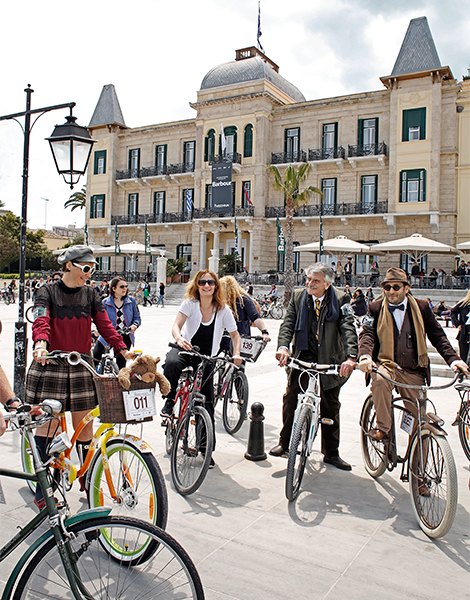The Spetsiots momentarily leave what they are doing, coming out of houses, shops and cafes to capture a curious spectacle: 200 cyclists of all ages riding through the village streets sporting flat caps, bowler hats, tweed jackets, bowties and other clothing from a bygone era. They have hairdos to match, thanks to the professional stylists who, a short while earlier, attended to the hair of the women and the beards of the men (the latter for the all-important mustache competition).
On the 23rd of April, the fourth annual Tweed Run was held, a celebration of early 20th century English style held on the island of Spetses. Indeed it is difficult to think of a more perfect setting for the well-mannered bike-ride and picnic than this island in the Saronic gulf, with its car-free streets, lined with the aristocratic mansions of old ship-owning families.
Tweed Runs are slowly becoming an institution, having begun in London in 2009, before spreading to New York and Tokyo. In 2014 the Poseidonion Grand Hotel held its first Tweed Run in Greece, in a fitting move for the historic hotel. Constructed in 1914, the Poseidonion was the first luxury resort to be built on any Greek island and the only hotel where the first well-heeled international travelers discovering the Greek islands could find such amenities as hot running water, private bathrooms and electric lights.

© Nikos Kokkas

© Nikos Kokkas

© Nikos Kokkas
Cycling like its 1929
The mood of the Tweed Run was cheerful throughout even though the weather chose to match the dress-style of the participants with Londonesque gray skies and a drizzle that rendered the woolen tweeds as practical as they were stylish. Many participants were decked out in jackets and clothes by Barbour, a key sponsor of the event. Others opted for true vintage garments and accessories acquired from grandparents or thrift shops.
Among the latter was Dimitris Karagiorgas who proudly showed me his grandfather’s pipe and pocket watch. For the ride, he sat atop a bicycle built in Germany in 1957 by the company Bismark that he had lovingly restored with authentic parts. He would soon be picking up an award for his vintage bicycle but faced stiff competition from Giorgos Kyriazidis, a winner of two previous competitions who maintains a collection of 7 vintage bikes.
“I took my first rides as a child on a ’57 Goricke,” he tells me. “Instead of a seat it had an old crate from a greengrocer’s. When I was older and I saw the bike rusting away, I decided not to let it become scrap metal. I like extending the lifespan of certain items, especially if they have a story behind them. You also have to be a little romantic. That’s how I got into restoring old bicycles, into Tweed and the aristocratic jaunt into the countryside, with picnics, good manners and without competitiveness.”

© Nikos Kokkas

© Nikos Kokkas

© Nikos Kokkas
“What makes a good antique bicycle?” I ask the judging panel whose members include Thanasis Sinanoglou, owner of the Greek Bicycle Museum. “It has to be older than 30 years and preferably as old as possible. We have seen bikes from as far back as 1922. We also judge based on the condition of the bike, the authenticity of the parts and its rarity,” Lia Kyritsi, another member of the judging panel tells me.
“Most people are here to experience an era that they have heard about, that they have seen in films and in their grandparents photographs. They achieve this with a classic bike and appropriate clothing at an aristocratic hotel on a beautiful island,” she says.
Of course, during the Tweed Run awards are also give to those with the best overall looks and styles. Among the judges is Panagiotis Grigoriou; the owner of two vintage-style barber shops (named 1900 and 1920), with a third soon to open (1930). He has been taking part in the Tweed Run since its very beginning and is perfectly turned out for the event, dressed in a flat cap, bowtie and tweeds – although for those that know him this is not unusual: he dresses like this every day.
“I am often asked if I have gotten dressed up for some photoshoot, but this is just my style. I like the values of that era. When even those who would go to a street protest, would do so wearing a jacket and a cap. One’s outward appearance is a very simple way to say complicated things,” he says. Are there many like him at the event who will continue wearing tweeds after the event? “You’ll see tomorrow, when almost everyone will be back in jeans!”











